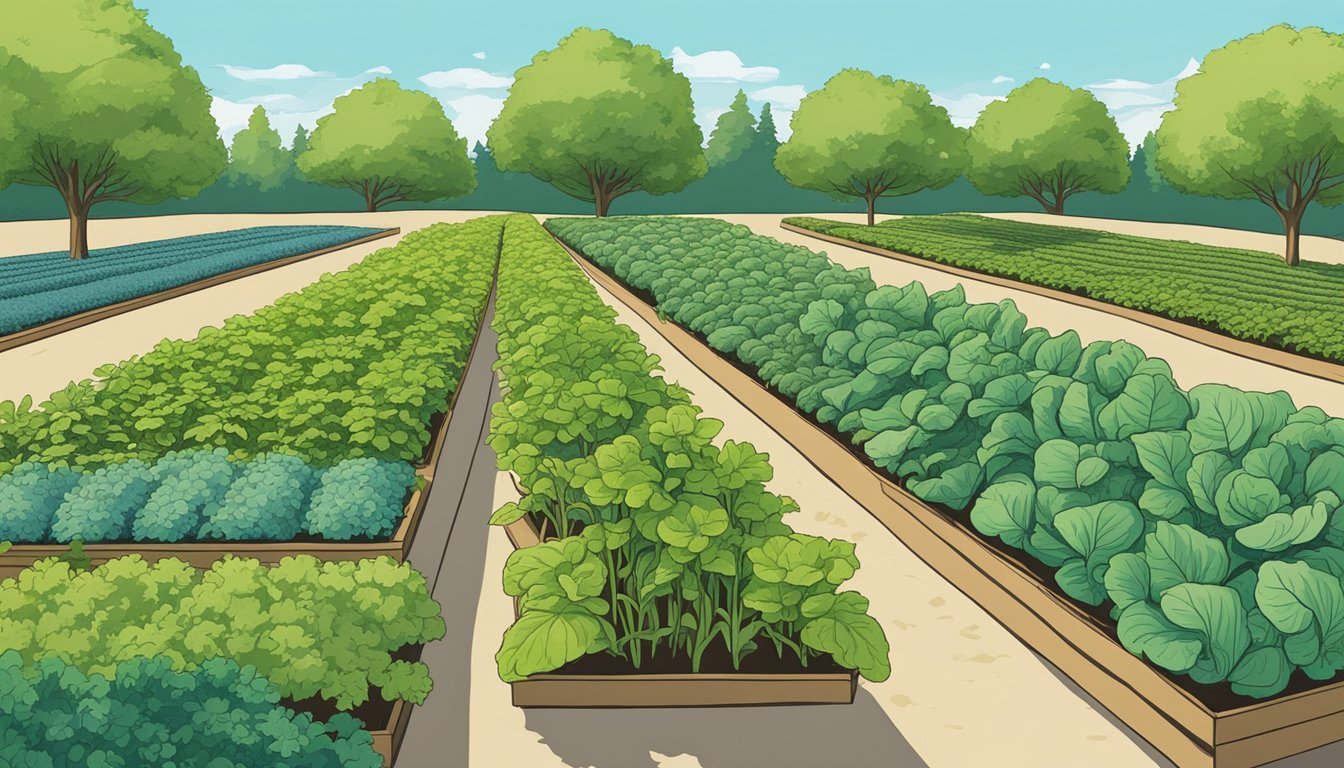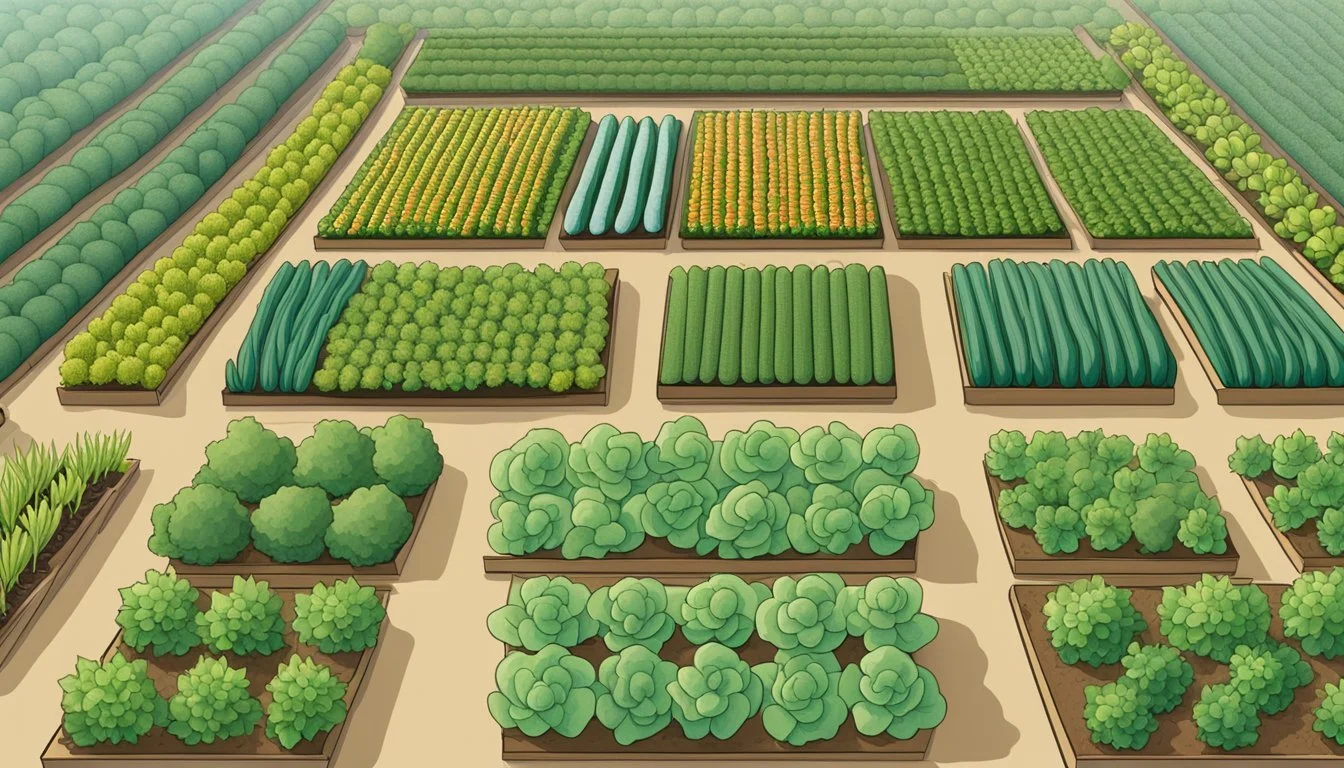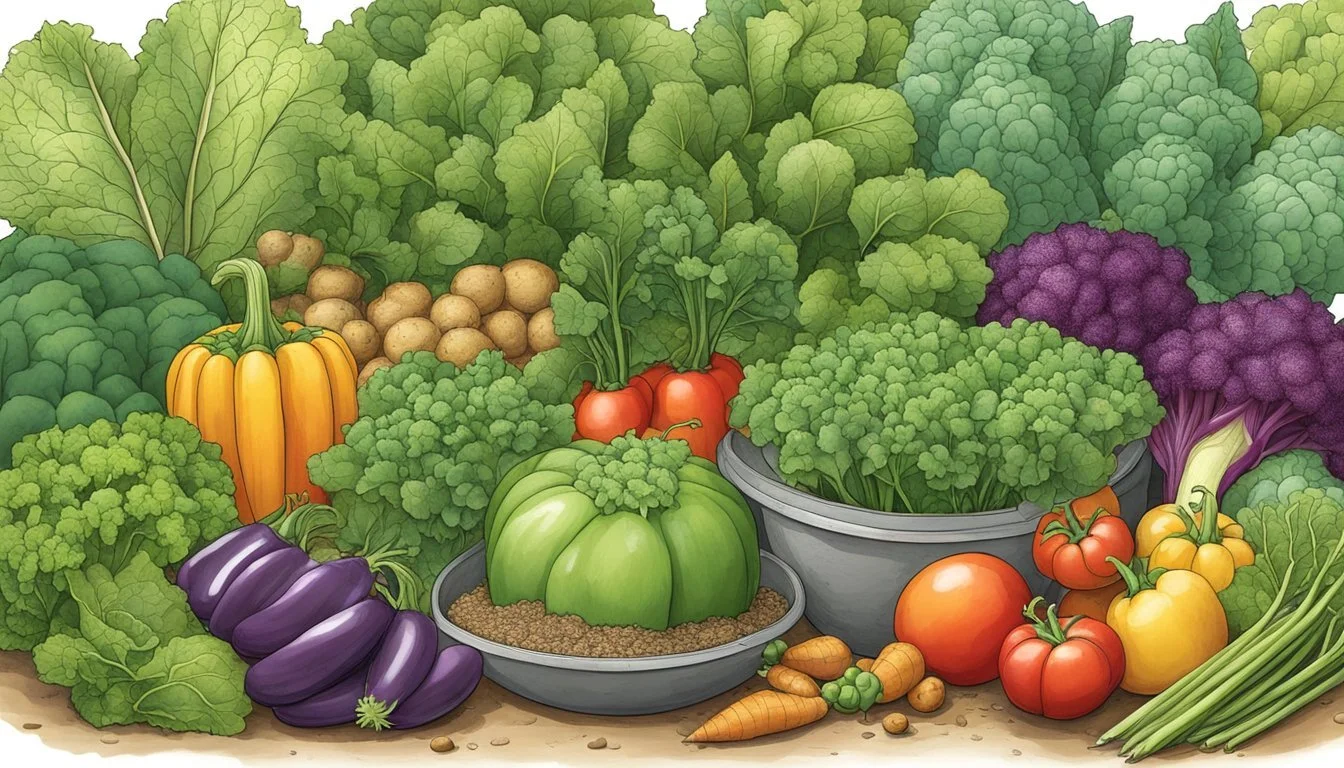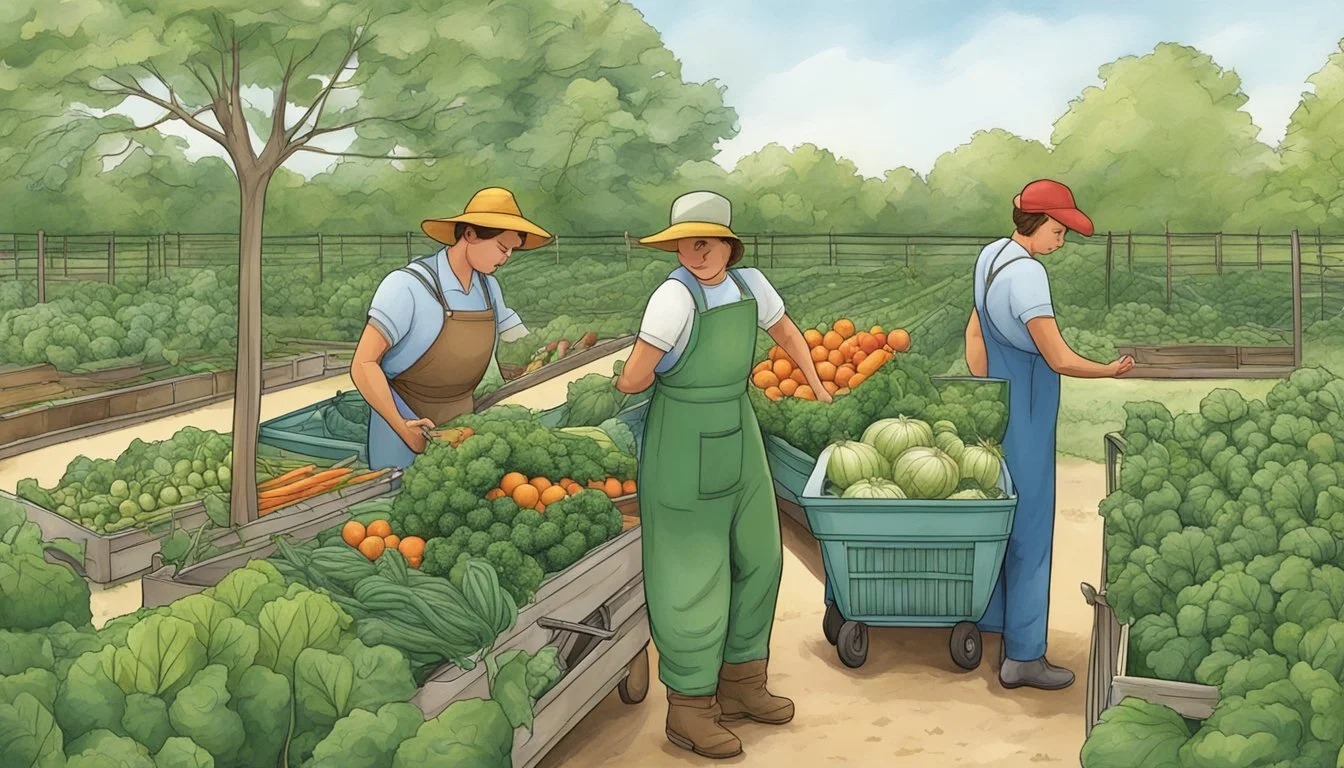Vegetable Gardening in Illinois
A Guide to a Thriving Harvest
This Article is Part of Our Guide on Vegetable Gardening by State
Vegetable gardening in Illinois offers a fulfilling opportunity for residents to cultivate their own food and enjoy the benefits of fresh, homegrown produce. The state's variable climate, spanning USDA plant hardiness zones 5 through 7, presents gardeners with unique challenges and rewards. With proper timing, selection of suitable crops, and an understanding of the first and last frost dates, Illinoisans can optimize their gardening endeavors.
Gardeners in Illinois can choose from a variety of vegetables that thrive in the region, from leafy greens to root vegetables. The key to a successful harvest lies in selecting the right vegetables that align with the state’s growing conditions. Some may require more attention and care to protect them from pests, while others might be more forgiving and quick to grow.
Planting schedules are essential for gardeners to ensure that vegetables are sowed or transplanted at the most opportune times. Utilizing resources like the Illinois Extension can aid in determining when to start seeds indoors or when to move plants outdoors. Given the right care and strategic planning, vegetable gardening in Illinois can be a highly rewarding experience that yields a plentiful and nutritious bounty.
Understanding Illinois' Gardening Climate
In assessing Illinois' gardening climate, one must consider the state's hardiness zones and the length of the growing season. Weather patterns also play a significant role, affecting when and what gardeners can plant for optimal growth.
Hardiness Zones and Growing Season
Illinois falls into USDA Plant Hardiness Zones 5a through 7a, delineating a gradient where winter temperatures can vary significantly. This classification is crucial for gardeners to understand the appropriate timeframe for planting and harvesting vegetables. Illinois' growing season can typically begin as early as April and may extend into October, depending on the region. The state experiences a first frost date ranging from early October in northern Illinois to late October or early November in the southern regions.
Gardeners must time their planting after the last frost of winter and before the first frost of fall to ensure a successful harvest. Below is an illustrative table with approximate first and last frost dates for key Illinois cities:
City Spring Last Frost Fall First Frost Chicago May 9 October 3 Springfield April 29 October 15 Carbondale April 14 October 21
Weather Patterns and Gardening Implications
Illinois' climate is characterized by cold winters and warm, humid summers. Summer temperatures often rise above 90°F (32°C), which can stress plants if not properly managed with watering and mulching techniques. While the heat of summer promotes the growth of a variety of vegetables, it is essential that gardeners are vigilant in providing sufficient moisture and shade to protect their crops.
The clear shift between the hot summers and the notably cold winters, sometimes bringing snow, affects not only planting times but also crop selection. Vegetables like lettuce stand out as suitable for Illinois' cooler months, having a tolerance for frost and even light snow cover.
Preparing for unpredictable weather, such as sudden frost or summer heatwaves, is a part of gardening in Illinois. Gardeners should stay informed with local forecasts and heeds advice specific to their region to moderate the effects of adverse weather.
Soil Preparation for Vegetable Gardens
Proper soil preparation is the cornerstone of a successful vegetable garden in Illinois. Key aspects include soil testing, amendment, and enhancement of organic matter and drainage to ensure optimal growing conditions.
Testing and Amending Soil
Testing the soil is the first crucial step in soil preparation. It informs the gardener about the pH level and nutrient content, enabling targeted amendments. Soil in Illinois often requires balancing to reach a pH between 6.0 to 6.8, which is ideal for most vegetables. One can purchase testing kits from garden centers or seek services from landscape recycling centers.
Once the soil test results are in, amending the soil becomes necessary to achieve a fertile soil profile. Common amendments for pH adjustments include adding lime to raise the pH or sulfur to lower it. For improving nutrient content, especially nitrogen, phosphorus, and potassium, gardeners can add organic or synthetic fertilizers depending on the specific deficiencies.
Organic Matter and Drainage
Incorporating organic matter into the soil is vital for soil health. Adding about 1/3 compost to the soil can significantly enhance its structure and fertility. Organic matter improves drainage in clay-rich soils and water retention in sandy soils.
Proper drainage ensures that water does not pool within the garden beds, which could lead to root diseases. For better drainage, elevated beds or raised rows might be considered, especially in areas with dense clay soils that are prevalent in Illinois.
By focusing on these fundamental aspects of soil preparation, Illinois gardeners can create a robust foundation for their vegetable gardens.
Selecting Vegetables for Illinois Gardens
In Illinois gardens, the success of a vegetable crop hinges on choosing the right vegetables and understanding the different requirements of cool-season and warm-season crops.
Choosing the Right Vegetables
Selecting the right vegetables for Illinois gardens involves considering the state's climate and the plant's soil preferences. Some of the best vegetables to grow in Illinois due to their adaptability and likelihood of success include:
Tomatoes: Thrive in warm conditions with well-drained soil.
Peppers: Require a good amount of sunlight and warm temperatures.
Carrots: Prefer cooler temperatures and deep, loose soil.
Squash: Need space to spread out or vertical support when trellised.
Cabbage: Performs well in cooler temperatures and fertile soil.
Beans: Varieties like green beans grow well in Illinois's climate.
Leafy Greens such as kale, spinach, and lettuce are excellent choices for Illinois gardens. They are particularly adaptable to the cool springs and falls:
Kale: A hardy vegetable that can even tolerate frost conditions.
Spinach: Grows best in cool weather with plentiful moisture.
Lettuce: Can be planted early as it tolerates cooler temperatures.
Cool-Season vs. Warm-Season Crops
Understanding the difference between cool-season and warm-season crops is crucial for garden planning in Illinois.
Cool-Season Crops:
They include spinach, lettuce, and kale, and can be planted early in spring or late in summer for a fall harvest.
These crops generally prefer temperatures between 40 and 70 degrees Fahrenheit.
Warm-Season Crops:
These include tomatoes, peppers, and squash, which should be planted after all danger of frost has passed.
Ideal temperatures for these crops are generally above 70 degrees Fahrenheit.
Gardeners in Illinois should time their planting schedules accordingly, ensuring that cool-season crops are not subjected to the hot midsummer temperatures and that warm-season crops have ample time to mature before the first fall frost.
Planting Strategies
Planting strategies are essential for a successful vegetable garden in Illinois. Gardeners must consider whether to start seeds (how long do seeds last?) indoors or plant outdoors, and how to effectively use transplants.
Seed Starting Indoors vs. Outdoor Planting
Starting seeds indoors allows for an earlier start to the growing season, as young plants can be established before the last frost date. Gardeners can control growing conditions including temperature, moisture, and light, which is crucial for delicate seedlings. Seed packets provide valuable information such as planting depth and spacing; this data can help ensure proper growth. Seedlings are usually ready for transplant after they have developed a strong root system and the outdoor temperatures are suitable.
Direct seeding outdoors, or planting seeds straight into the garden soil, is a strategy best suited to crops that do not transplant well, such as carrots and radishes. The timing is critical; gardeners must adhere to planting dates to ensure seeds aren't exposed to frost. Direct seeding works well for plants that grow quickly and are frost tolerant.
Using Transplants in Your Vegetable Garden
Gardeners often use transplants for crops that require a longer growing season than Illinois weather provides. Tomato, pepper, and eggplant transplants, for example, could be started indoors or purchased, allowing for a head start compared to direct seeding.
When transplanting, it is crucial to 'harden off' seedlings by gradually exposing them to outdoor conditions over a series of days. This will reduce shock and improve their chance of thriving when moved to the garden. Once acclimated, plants should be placed in the ground at the same depth they were growing at in their pots to prevent stem damage and encourage strong growth.
Garden Layout and Plant Spacing
A successful vegetable garden in Illinois starts with a thoughtfully planned layout and precise plant spacing, ensuring optimal growth conditions and ease of maintenance.
Developing Efficient Garden Beds
Gardeners should design garden beds with accessibility and sunlight exposure in mind. Beds that are no wider than four feet allow for easy reach from both sides; this is crucial for maintenance without stepping onto the planting soil, which can compact it and hinder plant growth. The orientation of rows should be north-south to maximize sun exposure, and sufficient pathways between beds must be factored in, allowing for easy passage and equipment transport.
Spacing Guidelines for Common Vegetables
Proper spacing between each vegetable is essential for healthy growth and yield. The spacing needs to vary widely among different vegetables. A practical approach is to consult seed packets or reliable gardening resources for specific spacing instructions, which can often range between 1–18 inches within rows. To illustrate, here are spacing guidelines for common vegetables grown in Illinois:
Tomatoes: Space plants 18–24 inches apart in rows spaced 3–4 feet apart.
Bell Peppers: Settle plants 12–18 inches apart in rows 2–3 feet wide.
Lettuces: Sow seeds or set transplants 4–8 inches apart in rows 12–18 inches apart.
Green Beans: Place seeds 2–4 inches apart in rows 18–24 inches wide.
Carrots: Thin seedlings to stand 2–3 inches apart in rows spaced 12–18 inches apart.
Implementing the right garden bed structures and adhering to precise spacing guidelines enables plants to thrive and can lead to a bountiful harvest in Illinois's diverse climate.
Maintaining a Productive Vegetable Garden
Maintaining a productive garden requires a well-thought-out approach to watering and plant management. An effective watering routine and strategic crop placement can significantly influence the harvest quality and quantity in Illinois's varied climate.
Watering Techniques and Schedule
Proper watering is critical for vegetable gardens. In Illinois, the climate necessitates a schedule that accommodates fluctuating rain patterns and high summer temperatures. Gardeners should aim for early morning watering to reduce evaporation and allow leaves to dry, minimizing disease risk. A general suggestion is one inch of water per week, either through rainfall or irrigation.
Drip irrigation: Efficient water delivery with minimal waste.
Soaker hoses: Offer deep watering, encouraging strong root development.
Rain gauges: Help monitor natural precipitation to adjust manual watering accordingly.
Crop Rotation and Companion Planting
Crop rotation and companion planting are essential to sustaining soil health and maximizing yields. Rotating crops each year minimizes pathogen and pest buildup. For example, a gardener should follow tomatoes with a non-solanaceous crop like beans or lettuce. In terms of companion planting, certain plants can complement each other by deterring pests or enhancing growth.
Crop Good Companions Benefits Tomatoes Basil, onions Improves flavor and repels pests Peppers Spinach, carrots Promotes healthy growth environments Cucumbers Radishes, peas Radishes can deter cucumber beetles
By integrating these practices into their gardening strategy, Illinois gardeners can nurture a garden that is both thriving and sustainable.
Pest and Disease Management
Effective management of pests and diseases is crucial for a successful vegetable garden in Illinois. Gardeners face various challenges but understanding common issues and control strategies can lead to healthier plants and more bountiful harvests.
Identifying Common Pests and Diseases
Identifying pests and diseases early is critical. Common pests include aphids, which are small, soft-bodied insects that feed on plant sap and can transmit diseases. Pests such as rabbits and deer may also cause damage, though they can be deterred with physical barriers. Diseases often manifest as abnormal growth or discoloration of plants. The University of Illinois Extension advises examining plants thoroughly before purchase to avoid introducing diseases into the garden.
Common Pests Description Aphids Small, sap-feeding insects that can spread diseases Rabbits Herbivores that can damage young plants Deer Larger mammals that eat plants and can be deterred with fencing
Organic and Chemical Control Methods
For organic control, introducing natural predators, such as ladybugs that consume aphids, is an effective strategy. Pulling weeds by hand and using barriers like bird netting can prevent pests without chemicals. Chemical control methods, including pesticides, should be used judiciously. Always select pesticides approved for use in vegetable gardens and apply them according to the label instructions. Balancing organic approaches with responsible use of chemicals is key in managing garden health.
Control Method Tools/Techniques Organic Natural predators, manual removal of weeds, physical barriers Chemical Pesticides specifically labeled for use in vegetable gardens
Harvesting and Preserving Your Vegetables
Successful vegetable gardening in Illinois culminates in the rewarding tasks of harvesting and preserving the fresh produce. Proper techniques ensure maximum flavor, nutrition, and longevity of vegetables.
Best Practices for Harvesting
Harvesting vegetables at their peak maturity ensures optimal quality and flavor. Different vegetables have specific signs that indicate ripeness:
Tomatoes: Deep, uniform color and slightly soft to the touch.
Leafy greens: Tender leaves before they become too large and tough.
Root vegetables: Firm roots that have reached the desired size. Carrots, for instance, should be firm and snappy.
To minimize damage and loss of freshness, the use of clean, sharp tools is essential. Gardeners should:
Harvest in the cool morning hours to take advantage of higher moisture levels in the produce.
Handle produce gently to avoid bruising, which can lead to quicker spoilage.
Wash vegetables with water to remove soil and potential residues, being particularly gentle with tender items like berries and leafy greens.
Techniques for Preserving Fresh Produce
Preserving the harvest allows enjoyment of homegrown vegetables long after the growing season ends. Here are the primary methods of preservation:
Canning: This method involves processing vegetables in a water bath or pressure canner which seals them in sterilized jars. Acidic foods like tomatoes can be safely canned with a water bath, while low-acid foods require pressure canning for safety.
Freezing: Freezing is one of the simplest preservation methods. Vegetables should be:
Blanched to preserve color, flavor, and texture.
Cooled immediately in ice water after blanching.
Dried and packed in airtight containers or freezer bags before being frozen.
Drying: Dehydrating vegetables removes moisture that bacteria, yeasts, and molds need to survive. Dehydrated produce can be stored in a cool, dark place for several months.
Slice vegetables uniformly for even drying.
Use a dehydrator or a low-temperature oven setting.
Pickling: Combining vegetables with vinegar, salt, and spices in a jar creates an environment where bacteria cannot thrive. Pickled vegetables (What wine goes well with pickled vegetables?) should be stored in a cool, dark place and given time for flavors to develop.
By following these harvesting and preserving practices, gardeners can maximize the benefits from their vegetable gardens, ensuring a bounty of fresh produce to enjoy throughout the year.
Additional Resources for Illinois Gardeners
Illinois offers a wealth of resources tailored to assist vegetable gardeners throughout their gardening season. These include comprehensive services provided by the Illinois Extension and supportive local gardening communities.
Illinois Extension Services
The Illinois Extension acts as a primary hub for gardeners seeking science-based insights. It provides guidance on which vegetables are well-suited to Illinois' climate, such as tomatoes, peppers, and leafy greens. Gardeners can discover techniques for soil evaluation, compatible planting strategies, and storage recommendations for seeds. Resources include:
Gardening Workshops: Scheduled events that cover a range of topics
Online Articles: Up-to-date research findings and practical advice
Seasonal Planning Guides: Information to help plan for the upcoming gardening season
Illinois Extension has educational materials specifically designed for those aiming to optimize their vegetable harvests in Illinois' unique climate.
Local Gardening Communities
Local gardening communities offer invaluable peer support and shared knowledge for both novice and experienced gardeners. Through these communities, individuals can:
Share Experiences: Talk about successes and challenges with local crops.
Swap Seeds and Resources: A common practice that benefits all gardeners.
Participate in Projects: Such as those organized by Illinois 4-H, which promote learning about food growth, preservation, and even profit generation from produce sales.








